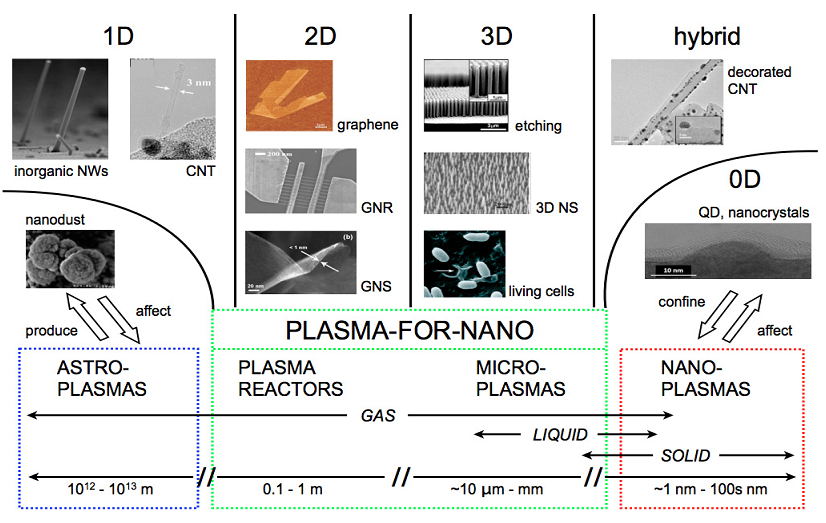Video Article Open Access
Plasma Nanoscience for Advanced Materials and Applications
Kostya (Ken) Ostrikov
School of Chemistry and Physics and Centre for Materials Science, Queensland University of Technology (QUT), Brisbane, Australia
Vid. Proc. Adv. Mater., Volume 3, Article ID 2208338 (2022)
DOI: 10.5185/vpoam.2022.08338
Publication Date (Web): 22 Dec 2022
Copyright © IAAM
Graphical Abstract

Abstract
This lecture introduces the fundamentals and discusses the recent progress achieved in plasma nanoscience research and its applications in materials science and technology, focusing on the authors contributions to the development and advancement of this research field. The advances made and the knowledge base created are critically examined by focusing on the key fundamental questions: (1) what happens when low-temperature plasmas face a solid object of nanoscale dimensions [1] and (2) how to utilize diverse plasma-specific effects to synthesize and post-process advanced functional materials for applications in diverse fields including but not limited to energy, environment and heath [2]?
These fundamental questions are at the foundations of the plasma nanoscience. The answers lead to better understanding of the many unique and interesting physical and chemical effects that could be generated through the nanoscale localizations of multi-phase interactions at plasma-solid interfaces under strongly non-equilibrium conditions.
Many synergistic effects appear through these interactions at the plasma interface. All other three states of matter can face the plasma and undergo significant transformations under the plasma exposure. The plasma effects enable several applications of low-temperature plasmas in micro- and nanofabrication, nanoscale materials synthesis and processing, industrial catalysis, new sustainable industrial processes based on green-chemistry approaches. Many exotic effects appear when the plasma itself is reduced to smaller dimensions, for example microplasmas. The selected examples are: plasma-nano catalysis and sustainable nanotechnology [3], as well as nanoscale plasma-surface interactions [4,5].
The lecture shows selected recent examples of using plasma, thermal, ionic and other processes to control macroscopic properties of materials by precise manipulations of atomic bonds, atoms and defects at nanoscales and the opportunities for applications in diverse fields including energy, environment and health [2-5]. The challenges and cross-disciplinary platforms on the way to materialize these ambitious goals are discussed as well.
Keywords
Plasma nanoscience; nanomaterials; plasma-surface interactions; advanced functional materials, applications in energy, environment, and health.
Acknowledgement
Contributions of all co-authors in relevant publications and the broader research community for advancing this research area are kindly acknowledged. Partial support from the Alexander von Humboldt Foundation through the Humboldt Award Program, the Australian Research Council (ARC), Centre for Materials Science, Centre for Clean Energy Technologies and Practices, and Centre for Waste-free-World is kindly appreciated.
References
- K. Ostrikov, Rev. Mod. Phys., 2005, 77, 489.
- K. Ostrikov, E. C. Neyts, and M. Meyyappan, Adv. Phys. 2013, 62, 113.
- E. Neyts, K. Ostrikov, et al. Chem. Rev. 2015, 115, 13408; K. Bazaka, J. Mohan, K. Ostrikov, Chem. Rev. 2016, 116, 163.
- W.-H. Chiang, D. Mariotti, R. M. Sankaran, J. G. Eden, K. Ostrikov, Adv. Mater. 2020, 32, 1905508.
- C. L. Ma, A. Nikiforov, N. De Geyter, X. F. Dai, R. Morent, K. Ostrikov, Prog. Polym. Sci. 2021, 118, 101410.
Biography
Kostya (Ken) Ostrikov has gained worldwide recognition across the fields of plasma science, nanoscience, materials science, and related areas of plasma applications. He is an acknowledged pioneer and leader in the rapidly emerging applied research area of Plasma Nanoscience and has been fundamental to the development of the field’s large international collaborative research community. Prof Ostrikov’s fundamental insights into using plasmas to structure nanoscale matter have been applied to the development of new advanced functional materials, devices and processes, which have applications in diverse research and technological fields. His approaches for control of energy and matter at nanoscales have been translated into a range of thermal, chemical, radiation and other processes. Their envisaged applications span the materials, energy, health and other fields, potentially leading to energy-efficient, green technologies for a sustainable future. Of special mention are recent physical insights into plasma and plasma-made nanostructure-enabled conversion of energy and matter leading to solar-thermal water purification and microbial sterilization and other applications, discovery of ion-enabled atomic bond manipulation that turn brittle ceramic materials superplastic, and mechanisms for the open-air plasma activation of fragile molecular matter to perform as a stable catalyst for hydrogen production under industry-relevant conditions. Prof. Ostrikov’s prolific publications in top journals across about 10 discipline areas have attracted over 28,000 citations (Google Scholar, GS) and H-index of 80 (GS) / 73 (Web of Science). His preeminent international standing and impact beyond his primary field are further evidenced by over 150 plenary, keynote and other invited talks, multiple prestigious awards, honours, fellowships and professorial appointments in 6 countries, including the recent Humbodt Prize (Research Award), career award and elections as Foreign Fellow of the European Academy of Sciences and as Foreign Member the Academia Europaea (Academy of Europe), all recognizing international pre-eminence in the research field.
Video Proceedings of Advanced Materials

Upcoming Congress



